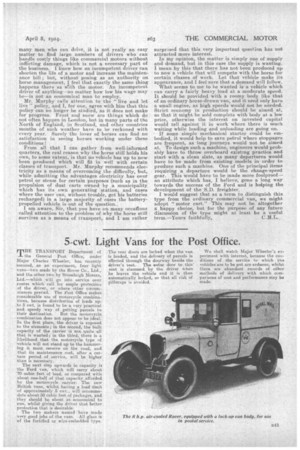5-cwt. Light Vans for the Post Office.
Page 27

If you've noticed an error in this article please click here to report it so we can fix it.
THE TRAY:SPORT Department of the General Post Office, under Major Charles Wheeler, has recently secured, as an experiment, four light vans—two made by the Rover Co., Ltd., and the other two by Stonelei.gh Motors, Ltd.—which will go into service over routes which: call for ample protectio.i of the driver, or where other circumstances prevail. The Post Office makels ,considcrable use of motorcycle combinations, because distribution of loads upto 5 cwt. is found to be a very practical and speedy way of getting parcels to
their destination. But the motorcycle combination does not, appear to be ideal. In the first place, the driver is exposed to the elements; in the second, the bulk capacity of the carrier is not quite all that is wanted; in the third, there is a likelihood that the motorcycle type of vehicle will not stand up to the hammering it must receive on the road, and that its maintenance cost, after a:certain period of service, will be higher . than is necessary.
The next step upwards in capacity is the Ford van, which will carry about
• oubio feet of load, as compared with about one-half of that capacity.affordecl by the motorcycle carrier. The FLEW British vans, whilst having a Ioad•limiti of approximateIY 5 cwt., will accommodate about 50 cubic feet of packages, and they should be about as economical to run, whilst giving the drivel' that better protection that is desirable.
The two makers named have made very, good jobs of the vans. All glass is of the fortified or wire-embedded type. The rear doors are locked when the van is loaded, and the delivery of parcels: is effected through the doorway beside the
driver's seat. The outer door to this' seat is slammed by the driver When lie leaves the vehicle and it is then automatically locked, so that all risk of pilferage is avoided. We shall watch Major Wheeler's experiment with interest; because the conditions of the service to which the vehicles are to be put arc arduous, whilst there are abundant records of other methods of delivery with which cumparisons of cost and performance may be made.






























